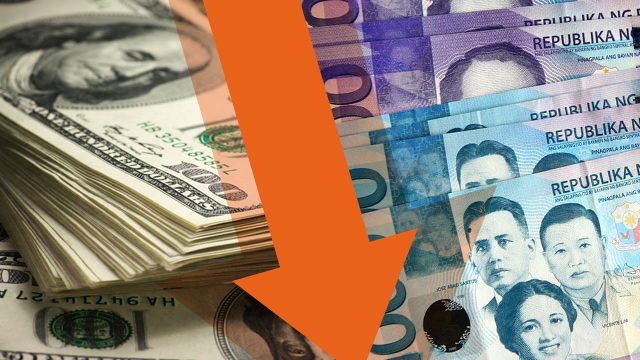SUMMARY
This is AI generated summarization, which may have errors. For context, always refer to the full article.

MANILA, Philippines – The Philippine peso shed 5.5 centavos to hit a fresh 10-year low of P50.27 to $1 on Monday, February 27, from the 50.215 to $1 last Friday, February 24, amid the expected rate hike by the US Federal Reserve next month and ahead of US President Donald Trump’s speech before Congress.
The local currency closed at its lowest level since it slid to P50.32 to $1 on September 26, 2006. (WATCH: Rappler Talk: Bob Herrera-Lim on the peso, worst performing currency)
On Monday, it opened weaker at P50.24 to $1 and depreciated further to an intraday low of P50.285 to $1. Volume amounted to $366.6 million, which was even lower than the $415.3 million booked last Friday.
Bangko Sentral ng Pilipinas (BSP) Deputy Governor Diwa Guinigundo said the perception of the exchange rate movement could be due to the uncertainties brought about by another rate hike in the US next month as well as the policies to be adopted by the Trump administration.
“First, people are talking about the March rate hike. Second, the uncertainties emanating from the economic policy agenda of the US government,” Guinigundo said. (READ: How a Fed rate hike impacts the Philippine economy)
Minutes released by the US Fed showed authorities expect to raise benchmark rates “fairly soon” after jacking up interest rates for the 2nd time in a decade with a 25-basis point increase last December.
“Remember that exchange rate continues to be driven by sentiment even as market fundamentals continued to be resilient particularly growth and inflation,” Guinigundo said.
The BSP sees inflation for the month of February kicking up to between 3.1% and 3.9% from 2.7% in January due to increases in oil prices, fares, and electricity rates.
Political noise
The administration of President Rodrigo Duterte also expects the country’s gross domestic product (GDP) growth to range between 6.5% and 7.5% this year from 6.8% last year, as it intends to ramp up infrastructure spending.
“Public finance is improving so that more and more infrastructure projects can be funded. These are stories that can actually drive the movement and the dynamics of the exchange rate,” he said. (READ: ‘Political noise’ not causing weaker peso – expert)
For his part, ING Bank Manila chief economist Joey Cuyegkeng said he believes local factors continued to dictate the weakening of the peso against the greenback, aggravated by Trump’s landmark address to the US Congress as well as the speeches of US Fed chairperson Janet Yellen and vice chairperson Stanley Fischer.
“We attribute this to local political uncertainties especially in the last couple of weeks. This set of political developments leading to intensified political noise results to cautious views tending to favor the US dollar rather than the peso,” he said.
Cuyegkeng also cited the country’s external payments position, including a widening trade deficit and lower current account surpluses resulting to the underperformance of the peso since the start of the year. – Rappler.com
Add a comment
How does this make you feel?
There are no comments yet. Add your comment to start the conversation.